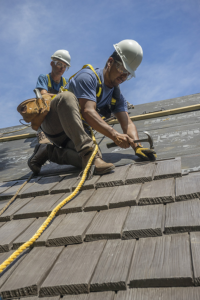Expert Roofers know that getting a permit for roofing is important. Typically, only licensed contractors can apply for a permit, and they will usually get the work done more quickly because they are familiar with the process. If you try to skip this step yourself or hire a contractor who wants to avoid bothering with the process, it could spell trouble down the road.
For example, if a building inspector drives by your house and notices that you are working on the roof without a permit, they can shut down the work immediately and send the roofers packing until the proper permits are in place. Sometimes, you may even be required to rip out the entire new roof and start over.

Additionally, a permit provides a valuable paper trail for your property. This information can be helpful when it comes time to sell the home, as potential buyers will want to see a record of all permitted work performed on the property. If you have yet to pull a permit for your roofing project, any warranty on the work will likely be voided. So don’t take chances – ask your expert roofer to pull the proper permits for you before they begin their work. It is a small sacrifice that could save you money and headache. Besides, it’s the right thing to do. You don’t want to be caught in a storm with a faulty roof!
The attic is not only a storage space but also provides valuable insulation for the home. Often overlooked by homeowners, the attic holds many secrets that can greatly impact your home’s energy efficiency, fire safety, and overall structure. But it can also be a home to pests like rats, mice, insects, squirrels, and even raccoons. In the winter, these creatures can hibernate under the eaves and attic vents. As a result, hearing heavy thumping noises in the attic may not just be an attic fan. It could be a critter trying to get into the house! Make sure you schedule roof maintenance before these creatures start chewing on the shingles.
Aside from the pests, neglected attics also have holes allowing invasive tree branches to reach the shingles and cause further damage.
The underlayment is a key part of your roofing system that acts as a barrier against moisture infiltration. It is a waterproof material that keeps water from penetrating your roof and damaging the wood framing underneath. However, if your underlayment isn’t properly installed, it may fail to do its job and leave your roofing vulnerable to leaks. It can also add unnecessary weight to your roof, putting additional strain on the wood framing and possibly leading to structural problems in your home. As a result, you must get your underlayment regularly inspected by an expert. The best way to avoid underlayment failure is to have regular inspections done by a reputable roofing contractor. These professionals can spot issues and fix them before they get worse.
The attic is often a forgotten feature of the house; it’s one that many homeowners only make a journey up to once or twice a year for roof maintenance. As a result, it needs to be addressed and addressed with a wide array of problems that could affect the home’s overall structure and energy efficiency. Sadly, neglecting the attic can also lead to a number of health and safety hazards for you and your family. So, when you encounter any signs of water damage in the attic, you must follow these tips for proper roof maintenance.
Your roof is your primary line of defense against harsh elements that don’t belong in your home, such as wind, sun and rain. Unfortunately, it can get damaged in a flash, such as when high winds tear off sections of shingles or puncture the roofing membrane. However, it can also suffer from slow damage that accumulates over time, such as a leaky roof that leads to mold and pest infestation. In either case, emergency roof repair is necessary to prevent further damage and potential structural problems.
You may need emergency roof repair for many different reasons, but most of them are caused by severe weather conditions. Some examples include high winds that cause shingle damage, tree damage to the roof that creates an entry point for water, and lightning damage that can weaken your roofing materials. In these cases, you will need to call an emergency roofer immediately so they can assess the situation and begin repairs immediately.
In some cases, it will be impossible to assess the severity of your roof damage until the weather has passed and it is safe to go outside and look at your house. During these times, it is a good idea to shut off your main electrical switch in the house and move furniture and personal belongings to safer locations. If there is a lot of rain or flooding, it may be a good idea to set out buckets or large plastic containers to catch the water and cover any items that can’t be moved with tarps.
You should never attempt to fix a problem with your roof yourself in a storm, or during any other kind of weather emergency. You could end up putting yourself and your family in danger, not to mention potentially voiding your homeowners’ insurance coverage by making improper or inadequate repairs. Instead, you should contact a professional emergency roofer who will be able to handle the entire process from start to finish. They can provide a detailed inspection, assist with filing an insurance claim, and perform any other necessary repairs that are deemed urgent.
Trees are the source of some of the most serious roof damage out there. They can fall, break, or cause other problems that lead to emergency repairs. These problems can include things like structural damage, clogged gutters, and even pest infestation. Luckily, most homeowner’s insurance covers this type of damage.
The most obvious problem caused by trees to your roof is when a limb or even an entire tree falls. This can create huge holes in your roof and cause major structural damage. It’s important to have a professional evaluate the damage and make any necessary repairs.
Another issue is when branches and leaves clog your gutters and drains. This can lead to water seepage and eventually rot your roof and foundation. This is why it’s important to keep trees trimmed and away from your home.
It’s also wise to have a professional tree service look at any trees close to your house on a regular basis. This way they can keep limbs from falling or even being knocked off by wind or other forces. They can also remove any weakened or dying trees before they fall over and do more damage.
If a tree or branch does fall on your roof, the first thing you should do is evacuate the house. This is especially important if the tree has taken down power lines. This could create a major safety hazard for your family and could lead to electrocution. It’s also important to call 911 as soon as possible so that the fire department can check out the situation and ensure everything is safe.
Once you’re safely out of the house, take a good look at the damage and any surrounding areas of your home. You may need to board up windows or shore up walls depending on the severity of the damage. Also, be sure to contact the local fire department and your power company if there are downed power lines.
While you can’t prevent every type of roofing damage, there are things you can do to limit the amount of damage you experience and slow down the deterioration of your roof. Regular inspections are the best way to spot potential problems before they become serious. During these inspections, it is important to take note of any areas of your roof that need immediate attention or repair.
If you have a shingle that is dislodged or missing, this is a sign of severe weather-related damage to your roof. This can leave your roof exposed to water damage, and it is important to call a roofer for an immediate repair.
You should also pay special attention to any areas of your roof that are particularly prone to leaks. These can include areas around the chimney, vent stacks and dormers. If you have any cracks or gaps in these areas, they should be repaired immediately to avoid costly damage to your roof.
Water damage is one of the most insidious forms of roofing damage and requires urgent repair. This can be caused by a number of factors, including storms, heavy rain or snow, and even the breakdown of roofing materials over time. Water can seep into cracks, under shingles and through flashing, often without you realizing it until it is too late.
Regardless of the cause of the leak, an emergency roofer will need to inspect your roof and determine the extent of the damage. This will involve taking photos, making notes and possibly putting up a tarp to protect the interior of your home until the full roof repair can be completed. Most reputable contractors will be happy to assist you with the insurance claim process as well.




